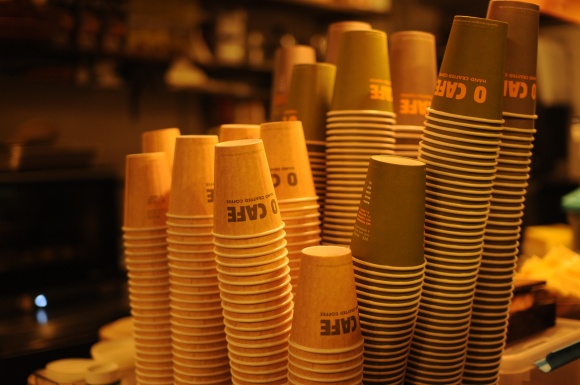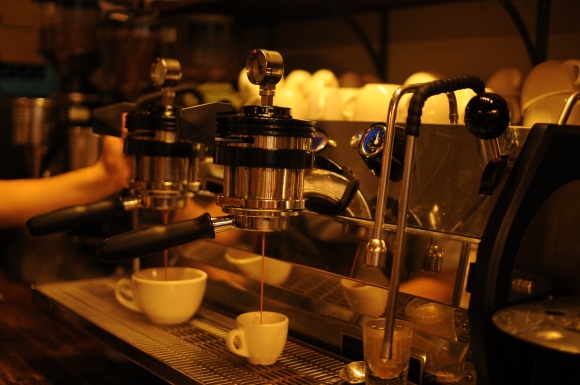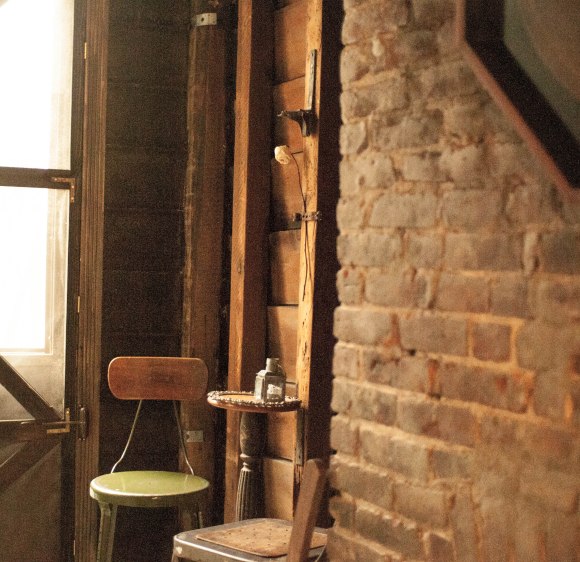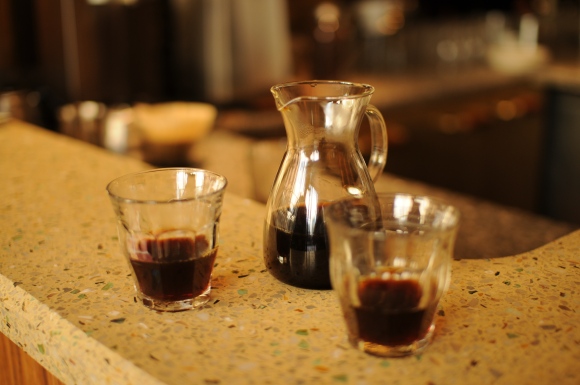On Friday, I visited O Café in the West Village and met with owner Fernando Aciar. Despite the heavy snow, the café was packed and it was easy to see why, with its fantastic coffee, delicious food and friendly service.


[Photos by Miji Lee & Miruh Jeon]
Before opening his café, Fernando worked as a chef in Rio, Sao Paolo, San Francisco and New York. He opened O Café to bring excellent coffee, along with great service, to his community. Moreover, he wanted to introduce high quality Brazilian coffee to New Yorkers. He exudes passion for what he does and is dedicated to building relationships with everyone he works with.



Fernando is seriously committed to maintaining an eco-friendly business. He himself designed the store and bulit the wood paneling on the walls, the tables, chairs, lamps, and pretty much everything inside the cafe (all from reclaimed wood). They use compostable cups, lids, utensils, napkins, etc. One side of the cafe presents a community wall, also built by Fernando, that provides information on where the cafe buys their ingredients.



O Café’s single origin cups are brewed to order using three different methods: Chemex for two, Hario V60 Pour Over, and Clever.
Chemex produces clean and sweet tasting coffee. The double filter they use is made of a kind of paper that retains more grinds; thus, it makes the coffee sweeter and cleaner with a light, crisp body.
Hario V60 Pour Over also produces a nice clean cup of coffee but not as clean as the chemex. The coffee is more floral with a full body.
Clever is a full immersion process that creates a cup similar to that of a V60 but with a fuller body. During this process, the coffee is set in hot water for two minutes. Because the coffee grinds are in contact with the hot water for a longer period of time, the coffee has a stronger body and a deeper character.
The taste of the cup depends a lot on the type of beans, as well has how you grind them. For instance, the coffee will taste more acidic when brewed with coarse grounds as opposed to fine ones. Also, fine grounds will give you darker, richer taste with more chocolate and sugar notes.

Coffee menu – drawings by Fernando Aciar
Some of O Cafe’s delicious beverage companions include:
Pao de queijo are Brazilian cheese balls. They are made from yucca flour and, so, are gluten free! These are great with black coffee.
Pao de mel is a Brazilian honey bread/cake. It is made with organic ingredients, including honey, walnuts, spices, and covered in dark chocolate. They are perfect with espresso.
Brigadeiros, Brazilian bonbons, are caramel candies covered with different toppings, such as pistachios and cocoa nibs. They pair great with iced coffee or espresso.
Chai raisin fig bread goes well with hot chocolate, tea, or a cortado.
Amma Chocolate, organic Brazilian chocolate, is available in the cafe in different cacao percentages. The café uses the 75% to make their hot/cold chocolate (with skim milk and NO sugar) and the house-made bahia chocolate sauce. Amma 75% is very rich, sweet, and fruity; it reminds you of the cocoa beans in the forest. And it’s healthy. This intense flavor makes a strong and delicious hot/cold chocolate.

Pao de queijo

Brigadeiros

1. You’ve worked as a chef for many years. What drew you to coffee? What persuaded you to to open a cafe?
I was cooking in my café/bistro in Rio, and I heard about baristas. I asked, “What is that?” and they said, “[a barista is] responsible for the coffee bar.” We had a café [in the bistro], and we had cappuccinos and mochas and espressos, but I didn’t know what the difference was. But, of course, there is a difference. This was like eight years ago. I went to take classes with my barista friend, [who] gave classes to me and my partner at the time in Rio, and we got completely crazy about it. We [learned about] the flavors of coffee, how this is completely different from that, etc. And we trained all our staff. From then on, there was no return. So, from there I started to improve and get better. I started to go to coffeehouses in Berkeley when I was working in San Francisco. I loved the coffee scene and coffee environment. When I moved to New York I said I would love to have a café; I would love to have Brazilian coffee. [I asked myself] why there weren’t any Brazilian coffee in the supermarkets? It was mostly all from Columbia, all from Africa, Central America, but no Brazilian. Brazil [has] a huge [coffee] market, and they drink all [their coffee] within and their good coffees don’t go outside [Brazil]. Specialty coffee in Brazil is pretty new; it has only [been] like 10 years. Even the biggest producer’s specialty coffee is very new for the outside market. So, I got very involved with that and started to travel and, then, quit my job here. I went for a year to Brazil to travel, talk to farmers, talk to the people [and] understand the process, [such as] washing and fermentation, and it was like learning wine [and] learning how to make cocoa.
We are always looking for the best coffee, the best experience, and the best service. There are many trends, there is all this new line of new coffee, and people want to do things that make them feel happy; but, I think, in the end it’s all about the experience. If you have great coffee with a great environment, you are going to be happy. If you have great coffee with a bad face and attitude, you are not going to be happy. So it’s about the whole experience.
2. Who is your roaster?
I was looking for the best roaster and found Joel Pollock of Panther Coffee. He’s a roaster and a buyer. I went to visit him in Portland and he was married to a Brazilian woman, who was a barista. At that time, I was willing to buy the coffee roasted by him from Portland, but they [had] decided to look for a place to move to and open a café. So, they opened up a coffee shop in Miami. We [actually] opened at the same time. So, he’s roasting my coffee now in Miami, and it’s [called] Panther Coffee, a very well known small roaster. Since then, we became very good friends and we are partners, in a way, that work together. I was his first account, and he’s been roasting the coffee [for my cafe] since the beginning. [When] he started to add more different coffees, I started to add more coffees here. We now have five different coffees, which rotate. We buy fresh coffee in small amounts, so [the coffee menu] changes seasonally.
I don’t go to the farms, because Joel is the buyer and roaster; we just buy from him the coffee that I want to buy. I know some farms he buys the coffees from in Brazil, but I don’t know the farms from Central America. But we support through him, through his job, all the small farmers. Our coffees are sometimes organic [and] sometimes they are not. What I care about is the treatment that the farmers get, because we mostly buy from small families. Only from Ethiopia do we buy from a co-op. Because coffee is a part of our culture and routine, I wanted to bring the best quality coffee. I know that I can get different coffees from different roasters, but I chose Panther Coffee because of the quality [of their coffee], their commitment and how they run their company. They are fantastic with their employees and with the farms. I helped them to opened their store and they helped me to open this store. They are hard workers and they love what they do, and I have the same commitment.
3. How would you describe Brazilian coffee to people that are not familiar with it?
Brazilian coffee is mellow and sweet. [As an] espresso, there are hints of orange zest and lemon zest. There is a lemony and orangey aftertaste, [as well as] a hazelnut and almond aftertaste. It has a nice body when it’s a drip cup. It is not too floral but has a beautiful sweet, mellow round body. Some new farms have very good coffee that reminds you of African coffee, but this is something new. New farms are coming and showing different products. Brazilian coffee used to be completely different, but the market requires different tastes. It’s a good base for everything. And espresso, for me, is the best.
4. What’s the story behind the name, O Cafe?
[We are] a local café with Brazilian products like coffee, acai, chocolate, coconut water, pao de mel, brigaderos, but I wanted it to be for everyone. In some ways it’s called O Café, which means “the coffee” in Portuguese, because of my café [in Rio]. When people used to ask, “where are you, Fernando, right now?” I used to say, “Oh, Im at o café. I am in my coffee shop in Rio.” So, the name came from the repetition of saying where I was all the time. It means the place and the coffee. People think it’s organic café, which is funny, [because] right now we carry a lot of organic stuff.
5. Chocolate seems to be an important part of your menu. When did you first develop an interest in chocolate/chocolate farms and how did that happen?
I had a friend and he’s one of the best pastry chefs in São Paulo, Brazil. He recommended me to visit some people who sent him samples of chocolate made in Brazil. In Brazil, [people] still buy chocolate from Valrhona or Callebaut, and it’s like why are they buying from European [companies] when they have farms in Brazil? [Many] people don’t believe in that, but this guy [my friend] believed in these people and helped them produce good quality chocolate. So, during my travels, I went to Bahia to meet somebody that was very involved in coffee farming and, also, in charge of the cupping for the Cup of Excellence; and it happened that he knew the guy from Amma [chocolate], who I am buying from now. They picked me up and drove me 3 hours and a half into the jungle. The cocoa farm is completely different from coffee farms; cocoa farms are in florestas, meaning rain forests, where you specifically need humidity in order for cocoa to grow. So, its wild, hot, and humid. You can climb the cocoa trees. When you get up there, you find these beautiful colors. The cocoa pods are pink, yellow, organge, purple, red and green. You cant believe what’s going on there. It’s just fantastic.
6. What are the weekly “laboratories” that you hold?
We only have cuppings now. The tables in the beginning were supposed to be for having labs and classes, but we became so busy that there was no way to do it. We open from 7 to 8, and 8 was too late for many people. We used to be open until 9:30. So, now we have only the public cuppings on Saturdays around 11 or noon. People can let us know and we are always going to be tasting coffee every Saturday. We are going to change the layout so we can have a table in the middle for trainings. Many customers want to be trained and they want to be more informed and know more; so we want to start doing that for our customers. This will happen before the spring.
Visit http://www.ocafeny.com for more info.





























































